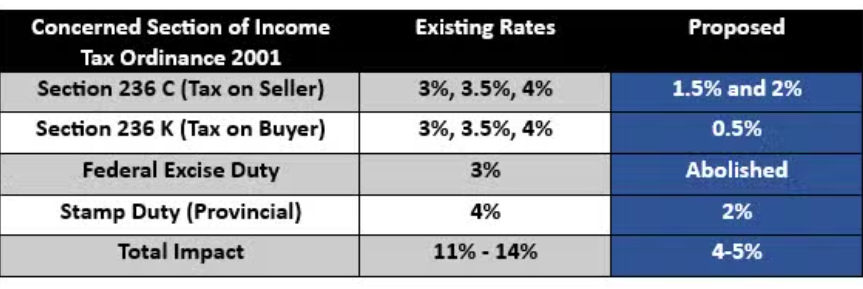Over the past year, significant tax increases in the property sector have created challenges for investors and homeowners. With new regulations restricting transactions for non-filers and the imposition of various tax categories, the government is now actively working on reforms to rejuvenate the housing sector. The Prime Minister has established a special task force under his supervision to recommend changes aimed at restoring growth in the sector.
Key Tax Reforms Under Consideration
1. Abolition of 7E Tax
One of the primary changes under discussion is the removal of the controversial 7E tax, which has been applied based on wealth statements rather than actual income. Since its introduction in 2022, this tax has faced criticism and legal challenges at various provincial courts. The Supreme Court is yet to rule on its fate, but the Prime Minister’s task force has signaled its complete abolition. The 7E tax was imposed on properties exceeding Rs. 25 million or those without an available MPAN (Market Price Assessment Number). The removal of this tax is expected to provide relief to property owners.
2. Property Transactions for Non-Filers
Recent tax law amendments prevented non-filers from purchasing property. However, the Federal Board of Revenue (FBR) has introduced a relaxation allowing transactions up to Rs. 1 crore without scrutiny. This “no questions asked” policy will enable individuals who are not tax filers to make property investments within this limit.
3. Uniform Tax Rates for Early and Late Filers
Currently, tax rates differ based on filing status, with late filers facing higher tax rates. The proposed reform aims to standardize property tax rates. Currently, early filers pay 3% tax on property transactions up to Rs. 5 crore, whereas late filers pay 6%. The new policy proposes a uniform tax rate of 3% for all transactions regardless of the filing status.
4. Simplified Process for Non-Resident Pakistanis (NRPs)
Non-Resident Pakistanis (NRPs) who stay outside Pakistan for more than 183 days currently face bureaucratic hurdles when transacting property. A new online portal will soon be introduced, allowing NRPs to verify their status through NADRA and execute transactions without needing commissioner approval. This will expedite the process and eliminate the requirement for physical presence.
5. CVT and Stamp Duty Adjustments
The government is considering abolishing the Capital Value Tax (CVT) in Islamabad and standardizing stamp duty across provinces. Currently, different provinces impose varied rates on property transactions, creating disparities. The proposed changes will ensure uniform tax collection nationwide and facilitate smoother transactions.
6. Standardized Property Valuation Periods
Property valuation rates set by the FBR have been unpredictable, sometimes increasing annually by as much as 80%. The government is planning a fixed three-year revision cycle for property valuations, ensuring predictability for investors. Additionally, special allowances will be granted for low-cost housing schemes and first-time homebuyers.
7. Reduction of Policy Rate Below 10%
To stimulate housing investment, the government aims to bring down the policy rate below 10%. Currently exceeding 12%, high-interest rates discourage borrowing for property purchases. A reduced rate will make mortgages more affordable, encourage bank loans, and support both private buyers and government-backed low-cost housing schemes.

Implementation Timeline
The task force is actively working on finalizing these reforms, with implementation expected within the next one to two months. Once confirmed, these changes will be enforced across Pakistan through the National Tax Council, ensuring a single, uniform tax structure for property transactions.
These proposed tax reforms reflect the government’s commitment to reviving the property sector and making real estate transactions more accessible. By removing restrictive taxes, streamlining processes for non-filers and NRPs, and stabilizing valuation periods, the reforms aim to foster investment confidence and sectoral growth. Stay updated for further developments on these crucial changes.




